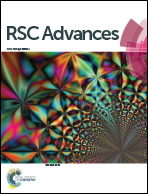A Au nanoflower@SiO2@CdTe/CdS/ZnS quantum dot multi-functional nanoprobe for photothermal treatment and cellular imaging†
Abstract
Au nanoparticle@SiO2@CdTe/CdS/ZnS quantum dot (QD) composite structures were synthesized by a liquid phase synthesis method. In this paper, three steps were adopted to gradually grow PVP-stabilized Au seeds from which PVP-stabilized Au nanoflower (NF) structures were successfully synthesized. For the sake of controlling the distance between Au NFs and QDs, silica was used as the shell material for coating Au NFs. The applications of this multi-functional nanoprobe in photothermal treatment and bio-labeling were demonstrated on MCF-7 and MDA-MB-231 breast cancer cells labeled with Au NF@SiO2@QDs. The experimental results of viability staining indicate that Au NF@SiO2@QDs composites with an excitation threshold of the photothermal effect of only 1.0 W cm−2 exhibit excellent photothermal conversion efficiency owing to the large absorption cross sections of Au NFs. Compared with that of pure QDs, the fluorescence efficiency of Au NF@SiO2@QDs was increased by 40%, which could be attributed to localized surface plasmon enhanced dipole radiation. Fluorescence imaging results reveal that Au NF@SiO2@QDs targeted the membrane of cancer cells showing strong fluorescence. Therefore, it can be concluded that the composite structure combines the therapeutic and diagnostic modalities.


 Please wait while we load your content...
Please wait while we load your content...